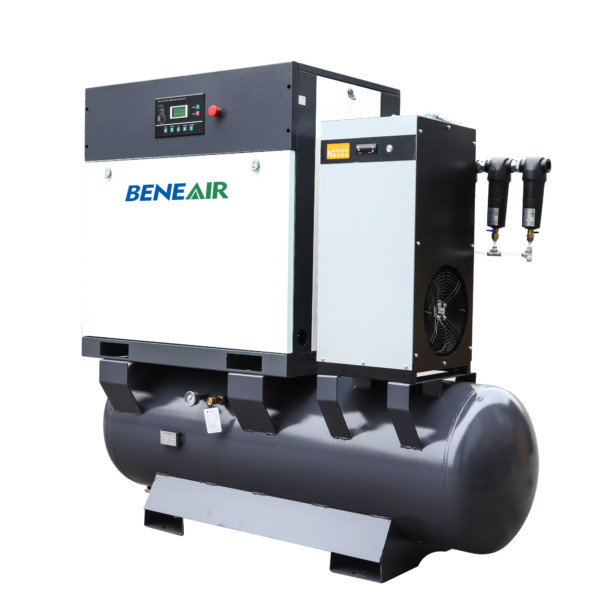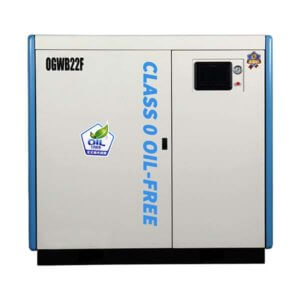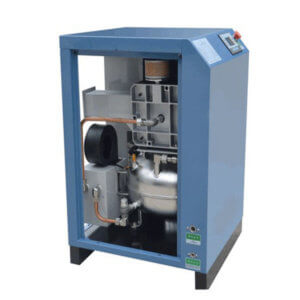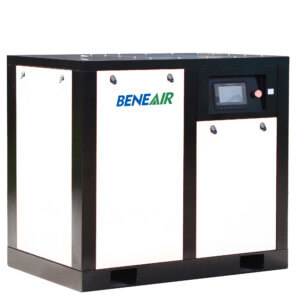Contents
Compressed air is used in many applications. However, under-designed systems are the leading cause of compact air problems resulting in reduced productivity and quality. The key to having a cost-efficient, productive system lies with the proper management of compressed air systems. A basic understanding of how an air compressor works and some knowledge on Best Practices for Compressed Air will help your operation have a more effective and efficient system.
How To operate the Rotary screw compressor more efficiently
How To operate the Rotary screw compressor more efficiently
The rotary screw compressor is a type of compressor that uses two helical screws (rotors) to compress air. They rotate in opposite directions and are interlaced with each other. Air is drawn into the compressor between the rotors, and as the rotors turn, the air is compressed.
These are some tips on how to operate the rotary screw compressor:
- Rotate with less RPM:
The rotary screw compressor can be operated with a lower RPM. Consequently, it will last longer and consume less energy.
- Air Cooling:
When the compressor is not in use, turn it off and air cool. The compressor will last longer this way.
- Only use when needed:
Rotary screw air compressors only come on when the machine needs to work. This saves a large amount of energy that would typically be wasted because it can turn off automatically after not being used for 5 minutes.
- Inspect the Compressor:
Before starting each shift, inspect all connections and fittings to ensure they are tight and there are no leaks.
- Reduce start-up time:
Reduce the start-up time by turning off all valves and allowing them to cool down. The compressor will last longer by using less wear and tear.
- Allow Compressor To Cool:
Rotary screw compressors produce a large amount of heat while running. To make sure your equipment is working properly, follow these tips.
- Oil the compressor:
A small amount of oil at the beginning and end of each shift will help extend the life of your rotary screw compressor.
- Use cleaning tools properly:
Using compressed air to clean can cause extensive damage to equipment and reduce its life span. Only use cleaning tools designed for compressed air and make sure they are properly maintained.
- Proper maintenance:
Having a regular maintenance schedule for your compressor will help keep it running at its best and extend its life span.
- Use the proper air filter:
Using the incorrect air filter can cause extensive damage to the compressor and reduce its life span. Make sure to use the correct air filter for your application.
- Cleaning Oil Trap:
Ensure the oil trap is cleaned every time you complete a maintenance check. This will help prevent any condensation build-up in your system, reducing its life span.
- Use piping correctly:
Always follow the guidelines set out by the compressor manufacturer to ensure all connections are secure and there are no leaks anywhere in the system.
- Correct air pressure:
Always make sure the compressed air is within the recommended pressure range specified by the compressor manufacturer. Exceeding this pressure can cause extensive damage to the equipment.
- Proper compressed air storage:
Always store compressed air in a clean, dry area. This will help prevent any moisture or dirt build-up in the lines, reducing its life span.
- Use a surge tank:
A surge air tank will help remove any rapid pressure changes when using air tools or systems with high demands on the compressor. This will ensure your rotary screw is not being asked to do more than it is designed for and extend its life span.

Safety Tips
Safety Tips
1) Make sure the compressor is turned off and unplugged before attempting to work on it.
2) Always wear appropriate safety gear when working on the compressor, including gloves, goggles, and masks.
3) Be sure none of the connections are loose and the compressor is not leaking before you start it.
4) Keep children and pets away from the compressor and its controls.
Schedule regular maintenance
Schedule regular maintenance
1) Before starting each shift, inspect all fittings and connections to ensure they are tight and there are no leaks.
2) When starting up, make sure the safety valve opens before the compressor comes on
3) Adjust air pressure as per requirements
4) Check belt tension regularly (every two weeks or so). Don’t let the belt be too tight or too loose.
5) Do a visual inspection of the compressor every day. Make sure it is in good working order.
6) Clean the compressor regularly (every month or so). By doing so, you can extend the lifespan of the compressor.
7) Lubricate all fittings and valves with a small amount of oil at the beginning and end of each shift.
8) Have an inspection and maintenance check performed by your local air compressor professional every year or so. This will help keep it running at its best and prevent major issues from occurring over time which can be very costly to fix.
Train Your Team
Train Your Team
1) Make sure all compressor operators are familiar with the safety procedures and safely start and shut down the machine.
2) Train them on how to adjust the air pressure as per requirements
3) Instruct them on adequately maintaining the compressor by regularly cleaning, lubricating, and inspecting it.
4) Show them how to identify any potential problems that may occur and what steps to take to correct them.
5) Let them know what an acceptable noise level is and what to do if they hear anything above that level.
6) Instruct them on the proper storage of compressed air to prevent any damage or corrosion.
By following these simple steps, you will ensure your rotary screw air compressor performs to its best and lasts for many years.
Although compressors can last for many years with proper maintenance, it’s essential to be aware of the common problems that can occur. By being proactive and following the recommended tips above, you can help keep your compressor running smoothly and prevent any costly repairs from happening in the future. Thanks for reading.










Leave A Comment